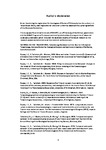Extinction and recovery dynamics of Triassic-Jurassic macro-invertebrate communities
| dc.contributor.supervisor | Twitchett, Richard | |
| dc.contributor.author | Opazo Mella, Luis Felipe | |
| dc.contributor.other | School of Geography, Earth and Environmental Sciences | en_US |
| dc.date.accessioned | 2012-10-22T10:18:30Z | |
| dc.date.available | 2012-10-22T10:18:30Z | |
| dc.date.issued | 2012 | |
| dc.date.issued | 2012 | |
| dc.identifier | 10119088 | en_US |
| dc.identifier.uri | http://hdl.handle.net/10026.1/1198 | |
| dc.description.abstract |
This work is focused on characterising and evaluating the intensity and selectivity of the marine fauna during the Tr/J mass extinction and recovery of the ecosystem in different localities throughout Pangaea. To address this, four localities were studied: St. Audrie’s Bay, Larne and Pinhay Bay in the UK, and Portezuelo Providencia in Chile. From each locality, samples were taken at approximately 1m intervals throughout the Tr/J sections. Species abundance per sample was estimated and each species was classified according to autoecological information derived from the literature. In order to assess changes in the structure and composition of the assemblages, NMDS and beta diversity index were performed, dominance and richness were estimated and the data were tested against five rank abundance (RAD) models. Ecospace modelling was used to estimate the loss in ecological diversity. Measures of the body size of bivalves and ichno-parameters were recorded on each section. Through the UK sections, the richness, dominance and the composition rate shifted abruptly during the extinction event. A geometric model shows the best fit during extinction events and, in contrast, a log-normal model best fits the pre-extinction and recovery event. The body size of the bivalves did not decrease during the Tr/J, while the coverage, richness and body size of ichnofossils increased during the recovery. The Chile Tr/J section records low richness, but the ecological complexity and richness decreases through the interval and composition records high turnover, while the dominance increases. The results indicate that the Tr/J disruption changed species composition in a relatively short time period, which decreased the ecological functionality of the invertebrate marine assemblage. In spatial terms, the UK fauna show a clear response to the extinction effect, but the diversity response of the Chilean assemblage is not clear at all, which may be related to taphonomical bias. Alternatively, this work analysed stage-by-stage occupation of ecospace of 3181 genera recorded from Sepkoski`s compendium for the marine fauna from the Late Permian to Early Jurassic. The ecospace can be represented as a combination of the three axes of tiering, motility and feeding, each divided into six subcategories. From the Cambrian to Recent, ecospace utilisation has tripled, however the trend through the Phanerozoic remains unclear. This result indicates that from the Guadalupian to Sinemurian the number of modes of life did not increase significantly, but the ecospace packing does. There was a significant positive correlation between abundance of predators and both infaunalisation and motility. However, the ecospace utilisation decreased 35% and 16% at the end of Permian and Triassic, respectively. During the extinction events, non-motile animals, organisms with little physiological control of biocalcification and the epifaunal forms, were heavily affected. This indicates that the mass extinction had a particular ecological effect on the biota and is an important episode of ecological changes due to ecological selectivity. Parallel, the appearance of adaptations to new trophic niches during the Triassic, like durophagy, presumably increased predation pressure and drove the increase in benthic infaunalisation. This series of adaptation could be potentially associated with the Marine Mesozoic Revolution. | en_US |
| dc.description.sponsorship | The Programme AlBan, the European Union Programme of High Level Scholarships for the Latin America, scholarship No (E07D402767CL) and CONICYT, Beca de Doctorado en el Extranjero por Gestión Propia 2007, given by the Chilean Government. | en_US |
| dc.language.iso | en | en_US |
| dc.publisher | University of Plymouth | en_US |
| dc.subject | Triassic-Jurassic | |
| dc.subject | Mass extinction | |
| dc.subject | Recovery | |
| dc.subject | CAMP | |
| dc.subject | Marine invertebrate | |
| dc.subject | Measures of Biodiversity | |
| dc.subject | Ecospace | |
| dc.subject | Ecological trends | |
| dc.subject | Marine Mesozoic Revolution | |
| dc.subject | Palaeoecology | en_US |
| dc.title | Extinction and recovery dynamics of Triassic-Jurassic macro-invertebrate communities | en_US |
| dc.type | Thesis | |
| plymouth.version | Full version | en_US |
| dc.identifier.doi | http://dx.doi.org/10.24382/4172 |
Files in this item
This item appears in the following Collection(s)
-
01 Research Theses Main Collection
Research Theses Main


